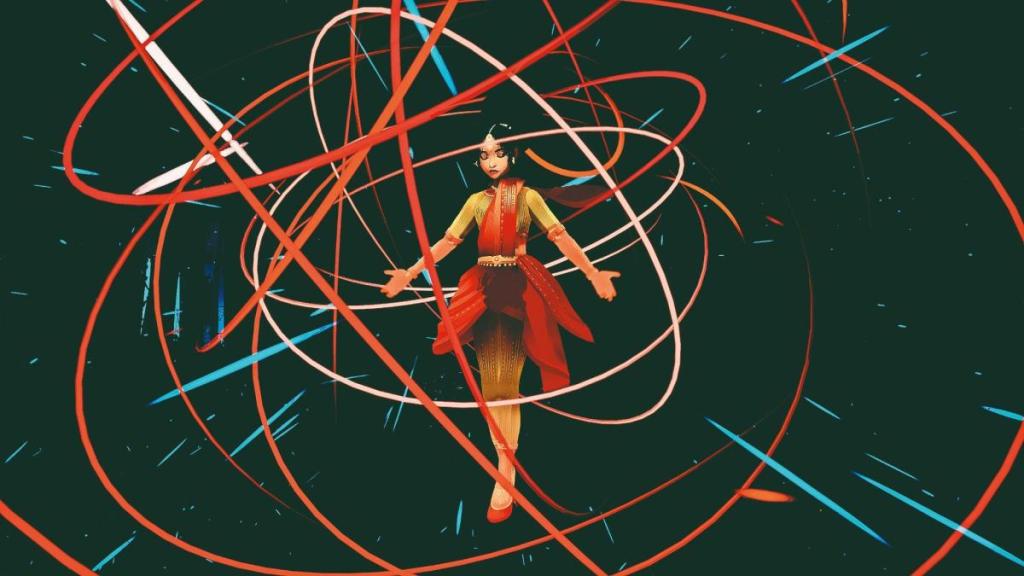In the beginning of Kolkata-born artist Poulomi Basu’s immersive installation, Maya: The Birth of a Superhero, the viewer wearing a Virtual Reality (VR) headset is asked to touch a tampon to progress the work’s narrative.
“It’s within our hands to control and change society,” says London-based Basu about the pivotal moment in her installation that is part of the inaugural Immersive Competition at the 77th Cannes Film Festival, which opened on May 14. Co-written and directed with British artist CJ Clarke, Maya: The Birth of a Superhero deconstructs the shame and stigma around menstruation.
The 33-minute work, which combines mixed reality and VR, tells the story about periods and sexuality of a woman stifling under shame and stigma. “It felt like an appropriate medium where you confront shame in close proximity. The medium itself becomes the message,” explains Basu about the interactive experience within the installation.
The result of a decade of Basu’s research into the taboo surrounding menstruating women in rural India and part of Nepal where they are banished from homes and kept in isolation during their periods, the installation becomes a journey from shame to empowerment.
The story of Maya, an immigrant Indian girl living in a tower hamlet in London who gets her first period in front of her school peers, Basu and Clarke’s work also probes misogyny and patriarchy in the West. Change arrives in little Maya’s life when she meets the mystical superhero, also called Maya, who comes to her in a dream. Game of Thrones actor Indira Varma plays the role of the superhero while doubling up as the immersive story narrator. London-based actor Charithra Chandran plays the role of the young Maya.
“The idea is to present a superhero character from South Asia with agency,” says Basu, Kolkata’s La Martinière and St Xavier’s College alumna, who relocated to the United Kingdom six years ago. The installation seeks to shift the narrative from rural India to show how the taboo and shame exist in sanitised Western societies as well.
“If you are brown or black, then your body is a fundamental site of political warfare. You become doubly oppressed, one by your race and the other by your gender,” she adds.
Installed at Cineum, a sprawling exhibition space on the outskirts of Cannes, and on the Georges Méliès campus of Côte d’Azur University, the Immersive Competition section, a first for the Cannes festival, has eight works along with six immersive works in a non-competitive category. A United Kingdom-France-United States production that had its world premiere at the South by Southwest Film Festival in Austin, Texas, in March this year, Maya: The Birth of a Superhero includes artworks like photographs of women in exile, child marriage, crimes against women and even medical scans of Basu and her friends who deal with debilitating reproductive health conditions.
The viewer, who carries the narrative forward from the initiation received by the touching of a tampon, inhabits a circular space where more interactive moments follow. The arrival of Maya, the superhero whose name suggests magic in Indian mythology, causes immediate impact. The shame and stigma disappears and the power of period surfaces. The blood that represents impurity suddenly becomes a vehicle for change.
The immersive work, which requires a Meta Oculus Quest 2, 3 or Quest Pro headset, uses hand-painted drawings that are transformed into 3D inside the headset by creating a 360-degree space. “The work uses ancient global Southern mythology and archaeology to bring feminine divinity and power to light,” says Basu, an award-winning artist and photographer whose last exhibition in India last year was based on a work commissioned by the Olympic Museum about young rural tribal girls and boys in Odisha who embody dreams of participating in Olympics.
Maya: The Birth of a Superhero will have a worldwide release on May 30 with a free download on Meta Quest. “Virtual Reality allows a more collective experience to understand what isolation means to menstruating women in a psychological way. No other medium can do it,” says Basu, a neurodiverse artist whose works relate to her own extreme ADHD (attention deficit hyperactivity disorder) and bipolar depression and extreme general anxiety disorder. “I have to take medication for endometriosis and menstrual disorder,” she adds.
Last year, Basu and Clarke took a 15-minute version of their immersive installation to the Tribeca film festival in New York where it received a Special Jury Award before it travelled to the Victoria and Albert Museum, London. “Women are treated like untouchables during periods. The installation takes viewers on a journey from shame to empowerment,” says Basu, who divides her time between Kolkata and London.
The inaugural Immersive Competition and non-competitive categories for works from around the world that combines virtual reality and mixed reality experiences along with projection mapping and holography. The immersive works reflect a cutting edge new era and new generation in storytelling that challenges convention. The first time the Cannes festival had embraced a virtual reality work was in 2017 when celebrated Mexican filmmaker Alejandro Iñárritu presented his virtual reality installation, Carne y Arena (Virtually Present, Physically Invisible), a powerful portrayal of the tragedy surrounding refugees. Iñárritu went on to win a Special Academy Award for the installation.
Faizal Khan is a freelancer









